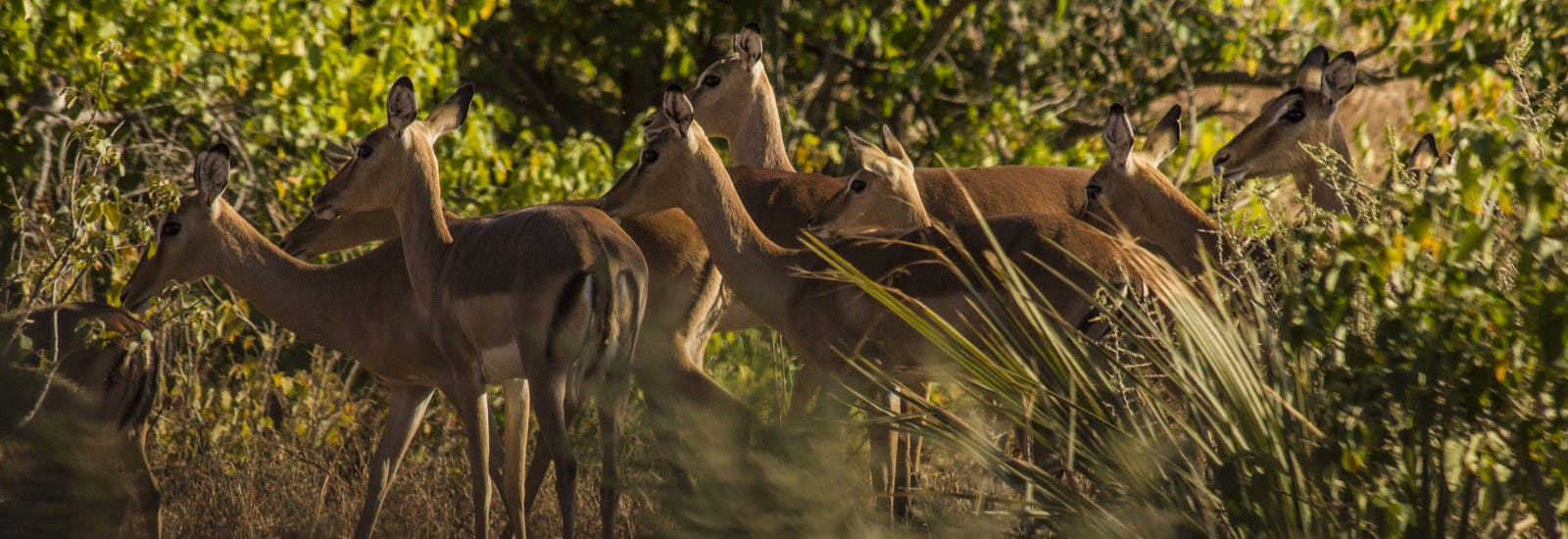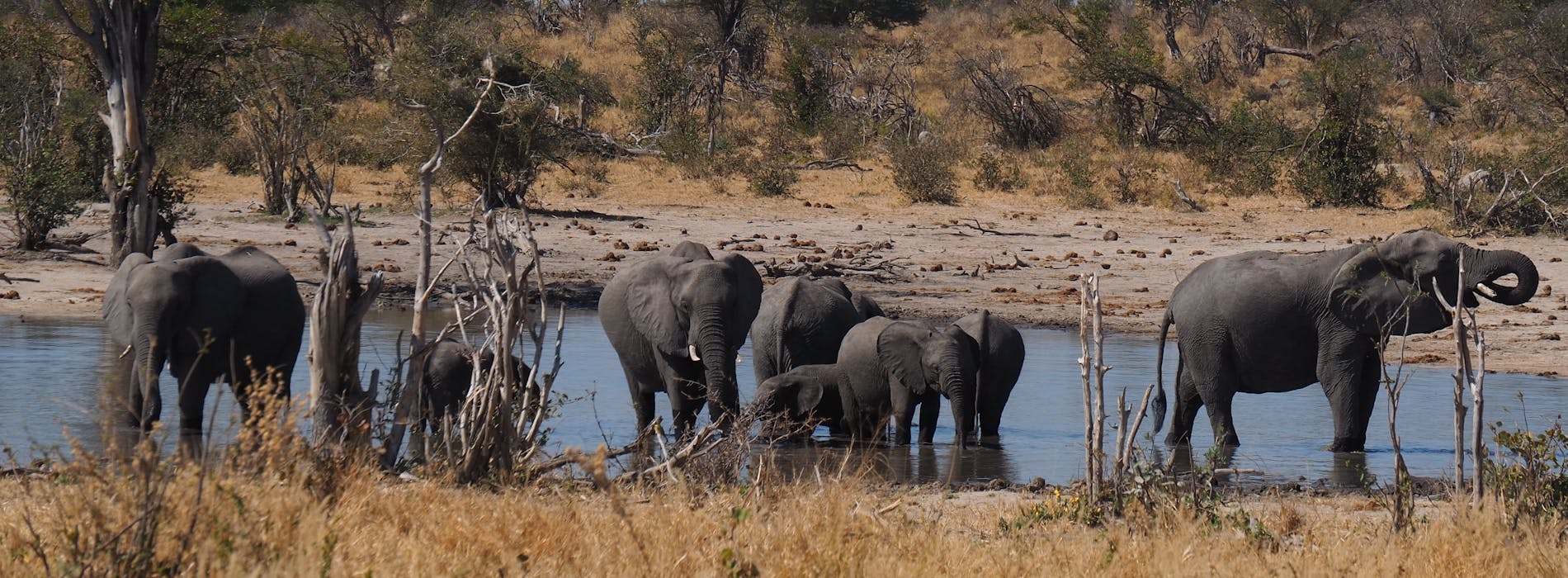
First reports from Tuli
Introduction
The Tuli conservation project is an opportunity to learn about and record data on the general wildlife and day-to-day environment of the Kwa-Tuli area, with specific reference to elephant and leopard numbers.
Data is recorded in a daily and weekly log and correlated for the monthly report. Key information includes interesting and unusual sightings, bird lists and raptor recordings, predator track and mortality records, weather and climate data and leopard and elephant sightings.
From the 7th November 2005, the students involved were Jonathan, Anna, Val, Tony and Michael. They were joined on Tuesday 22nd November by Tom, Jack, Angus, David and Harriet. Natasha has recently joined the project as well.
Overview
The weather throughout November has been extremely unpredictable and variable which has definitely had an impact on our data recording. Two days prior to our arrival on 7th November there had been the first rain, up to 50mm, and there were sizeable pools in the river and the first shoots of green in the landscape. The temperature was consistently well over 35C however and there was no sign of further rain. Possibly due to this initial rainfall, we saw immediate evidence of wildlife including various antelope, zebra, mongoose, jackal, porcupine and even wildebeest. There were numerous sizeable elephant sightings, possibly due to the water in the river and at Mamatumi, plus leopard track sightings showing evidence of more than three different leopards, both male and female. In addition, there was a notable increase in the number of antelope carcasses found, many appeared to have died from natural causes, presumably due to lack of rain and poor grazing.
Elephants
Elephants have been sighted throughout Kwa-Tuli at various times of the day and night. The most common places where we have seen elephants have been near water, especially Mamatumi and crossing the river at the entrance to Koro Camp. A significant number of our sightings have been at dusk, after 18:00, especially the sightings at Koro Camp.
Statistics:
Total Animals: 471
Number of infants: 18
Number of bulls: 18
Tuskless individuals: 18
Total herds: 33
Distant sightings:
Total Animals: 405 (approx.)
Number of Bulls: 8 (approx.)
Identification sheets:
Individuals identified: 75
Bulls identified: 5
Leopards
Leopard track recordings:
We have identified five definite individuals from their tracks and sightings. From these track recordings we are starting to piece together the territories of these individuals and we are also able to follow their movement and behaviour. A number of definite leopard kills have confirmed the information we gathered from tracks. It is interesting to note that no leopard kills have been either dragged into trees or been re-visited which suggests there is both a plentiful supply of food and a lack of predator competition.
The leopards identified have been named as:
- Koro Camp Female
- Koro Camp Female’s cub (thought to be male, approx. 8–10 mths old)
- Elephant Springs Female
- Big Boy
- Unidentified Male
Leopard sightings:
14th November 2005. 17:45. Map Reference 12B.
Koro Camp Female with cub. Both were lying down on the koppie to the left of the main highway at map reference 12B. Mother and cub were 20 metres apart and after about 20 minutes moved off together behind the koppie in a southwesterly direction.
17th November 2005. 19:05. Map Reference 6D.
Unidentified Male. First seen on the summit of a koppie at twilight. He lay still for a while and then moved towards the vehicle, at a distance of around 20 metres. He prowled parallel to the vehicle, walking left and right for about 10 minutes and then moved out of sight. Darkness prevented us from following his movement.
24th November 2005. 07:30. Map Reference 10D.
Probable Elephant Springs Female. Jerry radioed Koro Camp around 07:15 with news that he was watching a leopard on a high koppie on Melanie’s drive. We arrived to find the leopard disappearing over the back of the koppie. Fresh tracks, identified as Elephant Springs Female have been sighted here and it is fair to assume this was her.
Game Count
Overview
The aim is to count game over the whole of Kwa-Tuli. We have built two routes which between them cover every single road. We are driving each route once per week, at a set time and speed. We are recording antelope plus notable game such as zebra and wildebeest.
For each species, we count sub-adult male, sub-adult female, males and females, plus unidentified individuals, and a total count. Following the game count we plot sights on the Kwa-Tuli map as a grid and in time will build up a representation of the game population.
Species recorded in November:
- Bushbuck
- Baboon
- Duiker
- Eland
- Impala
- Kudu
- Klipspringer
- Steenbok
- Waterbuck
- Wildebeest
- Warthog
- Zebra
- Vervet Monkey
As this is in the early days there is as yet insufficient data to assess numbers of species.
Birds & Raptors
Overview
We are monitoring three areas. Bird species seen in Kwa-Tuli, summer migrants that have arrived and raptors.
Total Birds Noted: 125
Summer migrants:
Large numbers of European swallows have been seen hawking over the river and also over bushes. They have also been seen roosting in low trees away from the river. Most of these swallows have been young birds with only a few adults. White-fronted bee-eaters are regularly seen catching insects around the camp. Lesser striped swallows were first recorded on 10th November, followed by wire-tailed swallows on 14th November and then housemartins in low numbers on the 13th November. One greenshank was seen flying past camp on 11th November.
Notable sightings:
- Rufus cheeked nightjar
- Saddle-billed stork
- Fiery necked nightjar
- Goliath heron
- Red-crested korhaan
- Kori bustard
- Striped cuckoo
- Southern ground hornbill
- Marabou stork
Raptors:
- Dark chanting goshawk
- Black-breasted snake eagle
- Pel’s fishing owl
- African fishing eagle
- Pearl’s spotted owl
- African hawk eagle
- Giant eagle owl
- Tawny eagle
- Spotted eagle owl
- Brown snake eagle
- African marsh harrier
- Martial eagle
- Lizard buzzard
- Bateleur eagle
- White-backed vulture
- Wahlberg’s eagle
- Gabar goshawk (Melanistic form)
- Barn owl
Interesting and unusual sightings:
- Porcupine – sighted during the day leaving a hole on a koppie
- Python skin – found at the base of the Baobab tree
- Slender mongoose
- Caracal – spotted on a night drive
- Banded mongoose – several troops seen at different locations
- Tomb bat – roosting at Mamatumi. Flying during the day
- Aardwolf – No visual, but tracks seen on road
- Black-backed jackal
- African wild cat – two separate night sightings
- Granulated rock scorpion – in the basin at Mamatumi
- Water monitor
- Bushbaby – various locations at night time
- Large spotted Genet
- Small spotted Genet
- Civet – tracks only in the island across from Koro Camp
- Springhares – spotted on night drives
- Hyaena – Both spotted and brown hyaena tracks appear regularly throughout Kwa-Tuli
- Eland – large herd seen twice near the airstrip
Mortality records:
We keep track of all carcasses that we discover during game drives. We hope to find evidence of leopard and other predator kills, plus information on other causes of death such as stress or disease.
Predator kills:
- Impala – 3
- Bushbuck – 3
- Kudu – 2
Natural causes/other:
- Bushbuck – 1
- Klipspringer – 2
Climate and weather:
We are recording rainfall, temperature – minimum and maximum, wind strength and direction, humidity and cloud cover.
We cannot build an accurate climate picture after just one month, but notable incidents include:
- First rain on 5th November. 40mm with a further 10mm on the 6th
- Next rainfall was not until the early hours of 12th November when 2mm fell
- Huge storm clouds formed on the 19th but only produced lightning and dust storms
- Rain fell at Mamatumi on the 22nd, but not at Koro Camp
- Rain fell all day on the 28th November, 10mm
- An estimated 20mm fell on the 30th November and on the 1st December the river flowed for the first time

